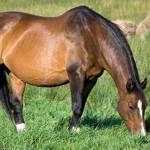Managing Broodmares on Fescue Hay or Pasture

On a sunny March afternoon, four heavy-bellied broodmares graze their way across the field and then wander back to the fence to munch their hay. All of them are close to their foaling dates. As a new horse owner and breeder, you’re looking forward to having a pasture full of playful colts and fillies.
Now jump forward to a day in April. The two chestnut mares are long overdue to foal. They show no udder enlargement or other signs that they will soon give birth. Three weeks ago, the gray mare produced a dead colt after a long and difficult delivery. The bay mare foaled normally but had no milk, and her filly had to be placed with a nurse mare. Neither mare has settled back in foal.
What went wrong? Your sympathetic old-timer neighbor has a one-word explanation: “fescue.”
To understand this hypothetical tragedy, let’s start with some definitions.
• Tall fescue: a popular pasture grass that is easily established, fast-growing, and hardy. It tolerates heavy grazing, drought, and competition from other plants, and is resistant to diseases and insect damage. Its extensive root system stabilizes the soil against erosion, and it offers nutritional value comparable to brome or orchard grass.
• Neotyphodium coenophialum: an endophytic fungus that infects the fescue plant and is mainly responsible for the resilient characteristics that make fescue so popular.
• Acremonium coenophialum: name by which Neotyphodium coenophialum was formerly known.
• Endophyte: a plant (in this case, a fungus) living within another plant.
• Alkaloid toxin: a substance produced by the endophytic fungus. It is present in fescue seeds, growing plants, and hay.
• Fescue toxicity: a condition affecting broodmares that graze fescue pasture or eat fescue hay. These mares may have multiple problems with reproduction.
• Endophyte-free fescue: strains of tall fescue (Kenhy, Alta, Phyter, and others) that do not contain the toxin-producing fungus. These strains are less hardy and require more intensive pasture management.
Fescue is widely distributed in pastures in many states, and infection by the endophytic fungus approaches 100% of plants in some areas. Cattle grazing fescue fields have problems such as decreased appetite and weight gain, but possibly the most dramatic negative effects of the endophyte are seen in mares in the latest stages of pregnancy. The fungus secretes one or more alkaloid toxins that interfere with hormone expression. Among the hormones involved may be relaxin, which dilates the cervix and allows pelvic joints to spread as the foal passes through the birth canal, and prolactin, which readies the mare’s body to begin lactation.
Until they are in the last trimester of pregnancy, mares can safely graze fescue pastures and eat hay that contains fescue. Most experts recommend removing the infected grass and hay from the mares’ diets for about the last 90 days of pregnancy to avoid problems. Mares that continue to eat fescue are at greatly increased risk of prolonged pregnancy and a difficult delivery of the overmature foal; thickening of the placenta leading to suffocation of the foal during birth; premature placental separation; and failure to produce colostrum or milk.
If mares have had access to fescue in the last trimester of pregnancy, a “better-late-than-never” intervention at any time before foaling can still keep problems to a minimum. The first step is to remove the mares from fescue pastures, switching them onto fescue-free hay or hay cubes. While 60 to 90 days is a recommended avoidance period, eliminating fescue for even a few weeks can make a difference in toxicity problems. The next step is to contact a veterinarian about treatment. Drugs such as domperidone and fluphenazine are often successful in reversing the negative effects of the alkaloid, and many treated mares are able to deliver and nurse their foals with few or no complications.
For mares with known or suspected fescue exposure, managers should be sure the foaling is attended and a veterinarian is available. This is recommended even if mares have been treated with domperidone or fluphenazine. The attendant may need to cut the thickened placenta or help the mare expel a very large foal that is several weeks overdue. A supply of colostrum should be available for foals whose dams cannot produce this vital protective fluid, and milk replacer or nurse mare services may be needed soon after the birth.
If mares cannot be removed from fescue fields, another approach is to remove fescue plants from pastures used by broodmares. This requires a rather expensive and time-consuming process of spraying, planting an alternative crop to smother new growth, repeating the spraying, and finally establishing a stand of a more desirable forage. Because success rates vary widely, farm owners who are able to take a field completely out of the grazing rotation may prefer to turn infected pasture into cropland for a few years. After existing fescue is destroyed, the field can be reseeded with low-endophyte or endophyte-free seed. Agricultural extension agents can be contacted for recommended procedures and replacement forage varieties in a particular area.
Inexpensive forage testing can help a farm owner or manager determine the level of endophyte infection on a field-by-field basis. Plant testing is effective only when the fescue is actively growing. Most labs will not test fescue hay because of erratic results. Agricultural extension offices can supply the address of the closest testing laboratory.








